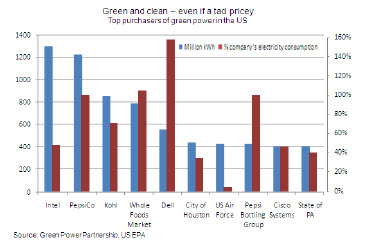This is a sample article from the December 2009 issue of EEnergy Informer.
Despite the economic downturn, demand for green power continues to grow
A survey by the Environmental Protection Agency (EPA) reported that the top 50 US purchasers bought more than 12.5 TWh of green power in 2008 with Intel Corporation holding the top spot, again.
The Green Power Partnership, a voluntary program with 1,100 participants, keeps track of voluntary purchasers of green power, defined as electricity from solar, wind, geothermal, biogas, biomass, and low impact small hydroelectric sources — excluding large hydro resources. Organizations can meet their requirements using any combination of Renewable Energy Certificates, on-site generation or utility green power products.

Separately, the National Renewable Energy Laboratory, (NREL), based in Golden, CO, keeps track of voluntary retail renewable electricity sales. NREL reported 2008 renewable sales exceeding 24 TWh, roughly 0.6% of total electricity consumption in the US with a market value of $110-190 million. Wind energy provided 71% of all renewable power sales, followed by biomass including landfill gas at 17%, hydropower 9%, geothermal 2% and solar at less than 1%.
Overall, the total number of customers purchasing renewable power increased by 15% in 2008, a slower rate than in previous years, with gains primarily in competitive markets and renewable energy certificates. Utility green pricing program participants remained essentially flat, with some programs reporting a loss of customers, which NREL attributes to the current economic downturn.
It must be noted that in states with renewable portfolio standards (RPS), the bulk of renewable generated power is “blended” with other types of generation and sold to customers, whether they ask for it or not, and regardless of their willingness to pay. The costs are typically spread across all consumers. The figures reported by EPA and NREL are voluntary purchases by consumers who are willing to pay a premium for the privilege of buying green electricity.
Starting with a handful of utilities offering green power products to their customers on a voluntary basis in the 1980s, the program has spread to some 850 utilities, roughly 25% of US utilities, today. For 2008, the price of green power for residential customers ranged from a saving of 1¢/kWh compared to standard utility service to a premium of 8.8¢/kWh, with 1.8¢/kWh as the average.
Since 2000, the renewable energy capacity serving green power markets has increased 40-fold and the annual average growth rate since 2004 has been 41%. “Green power markets provide an additional revenue stream for renewable energy projects, and raise consumer awareness of the benefits of renewable energy,” according to NREL’s Lori Bird.

